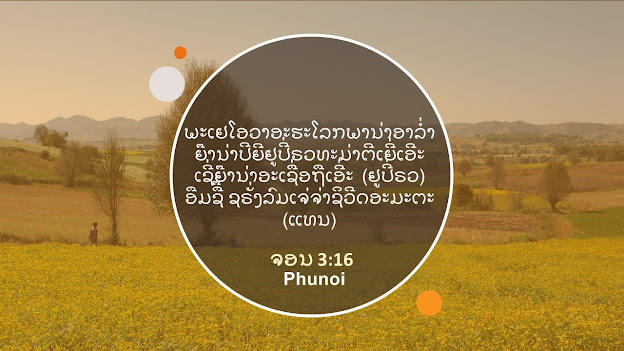John 3:16 in Phunoi, Punoi, Phu Noi, Phounoi, Côông, Cống, Khong, ผู้น้อย, ຜູ້ນ້ອຍ
ພະເຢໂອວາອະຮະໂລກພານ່າອາລ່ຳ
ຍ໊ານ່າປີຍີຢູປີ່ຣວທະມ່າຕີເຍີ່ເອີະ
ເຊີ່ຍ໊ານ່າອະເຊື່ອຖືເອີ່ະ (ຢູປີ່ຣວ)
ອືມຊື໊ ຊຣັ່ງລົມເຈ່ຈ່າຊິວີດອະມະຕະ(ແທນ)
ຈອນ 3:16
From Joshua Project:
From Wikipedia:
The Phunoi (Thai: ผู้น้อย; Lao: ຜູ້ນ້ອຍ; also spelled Phu Noi or Phounoi, and called Côông, Cống, or formerly Khong in Vietnam) are a tribal people of Laos, Northern Thailand, and Vietnam. They are related to the Mpi people and the Bisu people.
Etymology[edit source]
"Phunoi" means "little man" in various Tai languages and is not this ethnic group's original name, which is probably "Khong".
Distribution[edit source]
There are approximately 35,600 Phunoi in Laos and 1,300 in Vietnam (the 1960 census indicated that there were approximately 6,500 at that time). In Laos, many Phunoi live in Phongsali Province (around the town of Phongsali), Louang Namtha Province, and Houaphanh Province. Some also live in Luang Phrabang Province and Vientiane Province, the remnant of those serving in the Royal Lao Armed Forces.
Culture[edit source]
They speak Phunoi, a Tibeto-Burman language that is classified as one of the Loloish languages. The community is divided into several clans, each with its own taboos and customs for ancestor worship. Their primary occupation is slash-and-burn agriculture. They also produce a variety of handicrafts, most notably rattan baskets and mats.
Joshua Project Continued:
The Phunoi are a Tibeto-Burman people with Mongoloid features. Like other Tibeto-Burman peoples, the Phunoi migrated from southern China into northern Laos. Their language is part of the Lolo linguistic groups, who were the dominant power in southern China in the eighth and ninth centuries. In the early ninth century, they made their way into Southeast Asia. Today, they inhabit portions of north-central Laos around Phongsali. We know very little about them, except that they are closely related to the Bisu, Pyen, and Mpi. Lacking specific information on the Phunoi, we know some generalizations about their probable lifestyles based on their location in northern Laos and neighboring ethnic groups with a similar background.
The hill peoples such as the Phunoi are hunters and gatherers of forest products, as well as farmers. However, their practice of shifting cultivation prevents them from establishing permanent villages. Hill peoples who live at higher elevations are firmly entrenched in their customs and traditions. In contrast, those who live closer to the lowland areas engage in limited trade with the neighboring villages, acquiring their languages and cultures.
Phunoi villages comprise small groups of houses made of wood or bamboo, built on stilts, and clustered against the sides of the hills. Their residential areas are usually adjacent to their farms. With the houses built above the ground, the family livestock—poultry, pigs and goats—run freely underneath the houses. Because they usually organize their villages around the tribal lineage, it is likely that their social structure is based on family units.
The northern provinces of Laos have an ideal climate for growing opium-producing poppies. The tribal people have traditionally used opium as a medicine, a cash or barter crop, and as a drug.
The Phunoi practice an ethnic religion, which is a blend of animism and ancestor worship. Animism includes the belief that forces of nature (wind, rivers, trees, earth) are attached to spirits or supernatural beings. These spirits help find or grow food, cure illness, and avert danger. Through sacrifice and ritual, the worshipper tries to manipulate the spirit to help him. Ancestor worship involves praying to deceased relatives for blessings, protection, and guidance. They believe these spirits are alive and need to be fed.
Laos is one of the poorest countries in Southeast Asia. Malaria, influenza, dysentery, and pneumonia are major health problems, and malnutrition is a problem. Infant mortality rates are high, and life expectancy is low. Many of the elite fled the country in 1975, including most of the country's physicians, which created a serious problem for the new government. They built village infirmaries and dispensaries, and they trained medical workers in most of the provinces. These village medical workers, often using only traditional medicinal herbs, now provide most of the country's primary health care. It is not adequate for the great need.
Pray for Phunoi decision makers to open their communities to Christ's ambassadors.
Pray the hearts of the Phunoi people would be stirred to hunger after God, to drink of living water.
Pray that a family-based movement to Christ will soon transform Phunoi society, blessing them spiritually and economically.
Pray for the Lord to move in the hearts of believers to give up their own rights and sacrifice their lives to see the Phunoi people blessed by the work of Jesus Christ, the only Savior.
Scripture Prayers for the Phunoi in Laos.
| Profile Source: Joshua Project |
| Global Prayer Digest: 2017-06-09 |
| People Name General | Phunoi, Cong |
| Phunoi | |
| Alternate Names | Phu Noy; Punoi; Xa Xam Khoong; Xa Xeng; Xam Khong |
| Population this Country | 42,000 |
| Population all Countries | 42,000 |
| Total Countries | 1 |
| Indigenous | Yes |
| Progress Scale | 1 ● |
| Unreached | Yes |
| Frontier People Group | Yes |
| GSEC | 0 (per PeopleGroups.org) |
| Pioneer Workers Needed | 1 |
| People ID | 14382 |
| ROP3 Code | 108015 |
| ROP25 Code | 306700 |
| ROP25 Name | Phunoi |
| Country | Laos | ||
| Region | Asia, Southeast | ||
| Continent | Asia | ||
| 10/40 Window | Yes | ||
| Persecution Rank | 31 (Open Doors top 50 rank, 1 = highest persecution ranking) | ||
| Phongsali, Oudomxai, Luang Namtha, Luang Prabang, and Houaphan provinces Source: Faces of the Unreached in Laos, 1999 | |||




.png)
